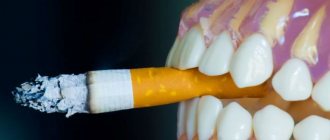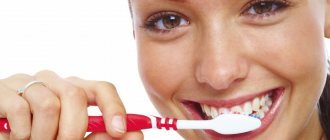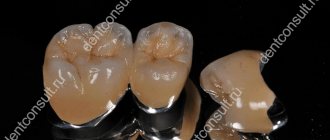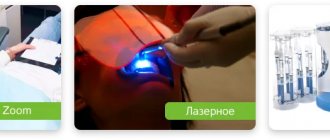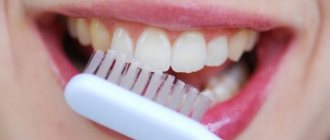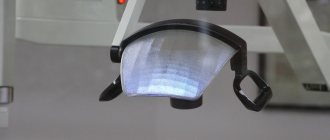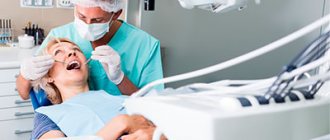The influence of tobacco heating systems, such as IQOS, on human health is now being actively studied, various hypotheses are put forward and tested. In particular, the issue of smoking has always caused certain problems with teeth.
In this article we will try to figure out whether it is possible to smoke IQOS after teeth whitening or other dental procedures, and how this type of smoking generally affects dental health. Dentists who have practice in this matter will help us with this. Let's start with the basics, with the influence of tobacco heating systems.
Is IQOS harmful to teeth?
The dangers of regular cigarettes have long been scientifically proven. There is evidence of irreparable damage to the health of smokers. A lot of life-threatening elements enter their bodies along with cigarette smoke. The harm of cigarettes is also visible in the oral cavity: teeth turn yellow and tartar appears.
However, not only smoke causes problems with teeth, but also severe temperature changes, from hot tobacco smoke to cool air. Such temperature changes negatively affect tooth enamel.
IQOS is much less harmful to teeth than regular cigarettes. Studies have shown that when using an electronic tobacco heating system, a person is exposed to 80-95% less harmful substances, this also applies to their penetration into the oral cavity.
The temperature of IQOS tobacco vapor is lower than that of cigarette smoke due to a special cooling element inside the sticks, as well as the absence of combustion.
Dentists note the following benefits of using IQOS:
- Dark brown plaque does not appear on the teeth. Resins do not penetrate into the oral cavity and do not affect the natural color of teeth. According to experts, cigarette smoke stains teeth 7 times more intensely than steam from IQOS.
- The risk of tartar formation is reduced. Brown plaque is considered the first sign of this problem. Since there is no dark plaque, the risk of stone formation is reduced.
- The risk of periodontal disease is reduced. The reason is the same: smoke does not affect the inner surface of the cheeks, oral cavity, or gums. In addition, the IQOS user does not experience such unpleasant sensations as dry mouth, burning, bitterness, and it is easier for him to practice oral hygiene.
- Implants do not fall out or be rejected. Considering that dental prosthetics is quite expensive, this is undoubtedly a plus.
Free IQOS test drive
I started my acquaintance with IQOS with a free test drive. To do this, I filled out a short form on the official IQOS website, after which a specialist called me and we agreed on a meeting. The next day he came to my work, brought the device and told me how to use it. I’ll say right away that I really liked IQOS. In addition to the advantages of IQOS that I have already mentioned, I also liked its stylish design - you must agree, holding a stylish device in your hands is much more pleasant than a pack of cigarettes. After 7 days, the expert came again to pick up the device and bring me a new one - I decided to purchase the IQOS 3 model.
I have been using IQOS 3 for more than six months and am thinking about purchasing another model - IQOS 3 Multi. In it, the main blocks - charger and holder - are combined into one. Thanks to this, the device can be used without recharging - up to 10 sessions in a row.
I have often thought about how IQOS affects the oral cavity, but there was little information about it. Smoking cigarettes had left my teeth with a characteristic yellow stain, and although I didn’t notice any changes with IQOS, I still wondered how using it could affect my teeth and mouth in general. IQOS specialists seemed to hear my thoughts and held a webinar that was dedicated to this topic. I was impressed, so I’m retelling it to you.
The essence of the whitening procedure
Teeth whitening is based on a couple of factors:
- Exposure to hydrogen peroxide entering the enamel and causing an oxidation process that destroys dyes.
- Ultraviolet, halogen or LED lamps and a laser beam speed up the reaction and make the procedure more effective.
After such an intervention, the teeth will become vulnerable:
- the enamel layer loosens, carious spots appear on it;
- sensitivity will increase;
- the likelihood of soft tissue irritation increases.
Proper dental care helps maintain the whitening effect for a long time and strengthen weakened enamel.
Types of in-office teeth whitening
The classification is determined by the ways in which the bleaching process is started. A whitening gel is applied to the tooth enamel and does not act until it is activated. If the trigger is a laser beam, then the whitening is called laser. If a special lamp (usually ultraviolet) is used for activation, then we are talking about photobleaching.
What stands apart here is the so-called intra-canal bleaching, which is used for pathological darkening of the tooth. Tooth whitening is carried out from the inside. After the required time, the whitening gel is removed and the canal is sealed.
Bleaching and smoking IQOS
After bleaching, it is not recommended to smoke cigarettes, drink strong tea, coffee, or eat foods with dyes, as excessive staining of teeth is possible within one week. Your daily diet should include foods high in calcium and fluoride, namely dairy products, eggs and fish. And, conversely, from your daily diet you need to exclude foods that can stain the enamel, for example, coffee, berries, juices. It is also recommended to eat solid and hot foods. The longer the patient adheres to the diet and does not consume dyes, the longer the whitening effect lasts. After the procedure, you can ask your dentist whether you can smoke IQOS cigarettes after brushing your teeth, what products are allowed for consumption, and when to come for the next session. Usually the specialist asks you to refrain from smoking in all its forms for some time, including the use of electronic cigarettes and IQOS.
Scientists have conducted studies in which they found that in the case of regular smoking, after bleaching, the particles contained in cigarettes quickly darken the enamel. The same method was applied to the teeth using IQOS systems. In this case, virtually no darkening was observed.
However, to minimize the risk of unwanted effects on enamel, it is recommended to wait a few hours before using IQOS. You should give up regular cigarettes for a couple of days, ideally 3-5, and only then start smoking.
If it is impossible to quit smoking tobacco for a few days, then it is better not to undergo teeth whitening. Its effectiveness will decrease several times if you do not follow the recommendations of dentists in the future. Permission to smoke IQOS is obtained not only after bleaching. You can also find out from your dentist whether you can smoke IQOS after tooth extraction, treatment of caries, periodontitis, or pulpitis.
Most often, in addition to whitening, people ask the question of whether it is possible to smoke IQOS after tooth extraction. The dentists’ answer here is clear: no, because there is an open wound in the mouth, which is not recommended to be exposed not only to smoke, but also to steam. You should distract yourself from the thought of smoking for at least 2-3 hours.
After cleaning, you should refrain from smoking IQOS for 2 hours, since as a result of removing tartar, an unprotected gap sometimes appears between the tooth and gums.
Reviews from users of the electronic tobacco heating system indicate isolated unpleasant sensations that occur when consuming IQOS immediately after brushing your teeth, but these are rather personal impressions.
Thus, using IQOS is much less harmful than consuming regular cigarettes. This applies to general health and the direct impact of IQOS on teeth. It is important to follow the recommendations of dentists and not harm your own health.
Restrictions after the procedure and terms of their observance
As a rule, after the procedure, the specialist gives the patient a leaflet indicating foods and drinks that should be avoided - the so-called white diet. In addition, the leaflet provides general recommendations that must be followed.
The transparent or white diet is a special diet that you need to follow after teeth whitening. Following such a diet will help avoid staining or darkening of lightened enamel.
First of all, the diet implies the exclusion of coloring pigment from the list of foods and drinks consumed. Already from the name of the diet it is clear that it includes light-colored foods.
Oral care
In addition to proper nutrition, we follow the rules of hygiene:
- We brush our teeth with a soft-bristled brush so as not to increase sensitivity.
- The paste should not contain abrasive components that damage the enamel layer. For two to three weeks after whitening, use a sensitivity-reducing toothpaste to brush your teeth, then switch to fluoride-containing products to strengthen your enamel and protect it from tooth decay.
- After your next meal, treat your teeth with an irrigator or floss - make it a habit.
- Use rinses that do not contain chlorhexidine, which stains enamel.
- Visit the dentist's office several times a year.
Electronic smoking devices are an alternative option for the most heavy smokers who cannot part with cigarettes. They are less harmful to the human body in general, and a limited number of elements enter the mouth that cannot have a significant effect on enamel pigmentation, the formation of plaque, tartar, and the appearance of periodontal disease.
You should listen to the recommendations of doctors and choose the safest smoking option, which significantly reduces the risk of general disease and the oral cavity in particular.
Ongoing care after whitening
High-quality hygiene. General rules are standard. Brush your teeth twice a day using toothpaste selected by your dentist. Floss is regularly used to clean the cervical part of the crown, lateral surfaces, and interdental space. It is advisable to use an irrigator twice a week to remove soft plaque.
Visits to the dentist. Performed once every 4-6 months for preventive examination and professional cleaning. During visits, the doctor monitors the result of whitening, changes in the color of tooth enamel, and carries out procedures to strengthen it.
Supportive procedures. To consolidate the whitening result and prolong it, do the following:
- professional teeth cleaning. A quick and painless procedure for removing soft plaque, developing tartar, and other deposits on the surface of crowns. It involves polishing the enamel, using enamel strengthening agents, which slows down the penetration of coloring pigments into it, helping to keep teeth white longer;
- instant whitening. Dentists at the DentoSpas clinic recommend Philips Zoom QuickPro lamp-free whitening, which can be performed every few months. It takes 30-40 minutes, lightens teeth by 1-4 shades on the Vita scale, and allows you to either gradually, in a gentle manner, achieve the lightest possible shade, or maintain the result of a previously performed procedure.
conclusions
So, smokers should take into account what dentists say about the effect of IQOS on the condition of teeth. If you have no desire to give up smoking, choosing devices for heating tobacco will most likely be more successful.
Although switching to IQOS may cause unpleasant symptoms, there will still be significantly less harm to health. Sticks for this device are a little more expensive than regular cigarettes, and here it’s worth deciding whether it’s worth saving on your health. Only IQOS causes addiction to nicotine in the same way as cigarettes. There are also unpleasant side effects and harm to health, so the greatest benefit for teeth, and health in general, will be a complete cessation of any type of smoking.
Myth #2: Whitening strips destroy enamel.
If you use them correctly, no. In any case, before carrying out this procedure for yourself, you must carefully read the instructions for your specific whitening strips. The rules are purely individual: some strips need to be kept on your teeth for half an hour, others will have to be left overnight. The main thing is not to overexpose them, because then they can really negatively affect the condition of the enamel. However, the effect will not be noticeable in one procedure: as a rule? The strips must be used in a course. Then your teeth can be whitened by 1-5 shades (more - only after professional whitening at the dentist).
There are also general features of using whitening strips. Before using them, you should not brush your teeth, and, of course, it is not recommended to eat food while they are on your teeth. After the strips, tooth sensitivity may be increased for some time, so for the first time it is advisable to give up coffee, red wine and smoking.
How smoking affects teeth
Smoking is harmful to the entire body, including the teeth, which are the first to bear the brunt of tobacco smoke and high temperatures. Under the influence of cigarettes, the enamel begins to deteriorate, microcracks appear on it, through which tobacco smoke substances and bacteria present on the teeth quickly penetrate.
Plaque formation in smokers occurs quickly, and it is difficult to remove it on your own. In addition, tobacco lovers are unlikely to brush their teeth after every cigarette they smoke. As a result, the enamel is destroyed, which leads to tooth decay, and the plaque gradually hardens, forming tartar, which contributes to the development of gum disease.
The longer a person smokes, the more their teeth will suffer. Gradually, negative processes will begin to progress, which will undoubtedly entail serious aesthetic and pathological consequences.
The effect of smoking on teeth color
At the first stage, the problem is purely aesthetic in nature, but if it is not addressed, plaque leads to the formation of tartar, and also causes inflammation of the gums and contributes to the development of caries. The plaque caused by smoking initially has a yellow tint, but over time becomes darker to grayish-brown and black.
Gum inflammation caused by this harmful habit can become serious, accompanied by bleeding, gingivitis, periodontal disease and chronic bleeding gums. Smokers are also at risk of developing tooth decay. Almost all lovers of this habit have teeth in their mouths that require treatment. Their caries develops quickly, endlessly transmitted from tooth to tooth.
In addition, there are statistics according to which four out of ten smokers completely lose their teeth by age 65. Among non-smokers this figure is two times lower.
There is no bad breath or dryness.
Most smokers, especially heavy smokers, are bothered by bad breath. Therefore, the question arises, are there any such consequences from the use of devices used to heat tobacco? Dentists assure that such consequences are unlikely from IQOS. After directly using IQOS, there is no smell of tobacco on your breath, nor on your hands, which is also an advantage. The only specific smell that someone may not like is the smell of smoke during smoking itself.
As a rule, there is no dry mouth. Due to the lack of exposure to smoke, the condition of the oral cavity hardly worsens. Users also notice that due to the absence of any combustion products and even resins, there is therefore no unpleasant bitterness in the mouth.
What can you eat
List of healthy permitted foods:
- cottage cheese, milk, low-fat sour cream, yogurt without additives;
- cucumbers, cabbage, potatoes, asparagus, celery;
- green grapes, pears, peeled apples, bananas;
- unleavened cheese;
- clear broth;
- white lean meat;
- seafood;
- white fish;
- mushrooms;
- some types of nuts;
- egg white;
- oatmeal, buckwheat and rice porridge;
- bread;
- pasta without sauce;
- water, clear fruit compote.
Even after 48 hours, experts recommend drinking weak green tea through a straw.
What not to eat
- Beets, tomatoes, carrots;
- Citrus fruits, watermelon, mango;
- Dark berries;
- Coffee, tea, cocoa;
- Red and rose wine;
- Lemonade, fruit drink;
- Ketchup, soy sauce, etc.;
- Egg yolk;
- Jam, jam;
- Chocolate, candy, caramel;
- Spices and seasonings;
- Chips, crackers;
- Any other foods and drinks containing dye.
Important! If you consume an illegal food or drink, immediately brush your teeth or use mouthwash.
Is the risk of periodontal disease reduced?
Periodontal disease is a very serious disease in which the last stage of gum inflammation occurs. Eventually, a person may begin to lose teeth, resulting in an inability to function normally, eat their favorite foods, and drink their favorite drinks. This will also lead to a lot of money spent.
Periodontal disease can be of different types, but its main cause is plaque on the teeth, which appears as a result of a variety of bad and not so bad habits. For example, frequent consumption of coffee, tea, smoking cigarettes, peculiarities of the composition of saliva, improper chewing, endocrine diseases, fixed orthodontic structures, etc. lead to the appearance of plaque on the teeth, which hardens over time, and when smoking, drinking coffee, and the like, the same the plaque becomes darker.
The types of periodontal disease include:
- supragingival calculus;
- subgingival calculus.
There is also a species called "stone bridge". This is the name for the phenomenon when periodontal disease covers two or more teeth in a row.
There is evidence of a study lasting several days that compared the effects of cigarette smoke and steam from a heater on the mucous membrane of the human mouth, his gums and, in fact, his teeth. It was found that the cytotoxicity of cigarettes is quite high, unlike IQOS.; However, steam also has an effect on the oral cavity, although not as strong.

